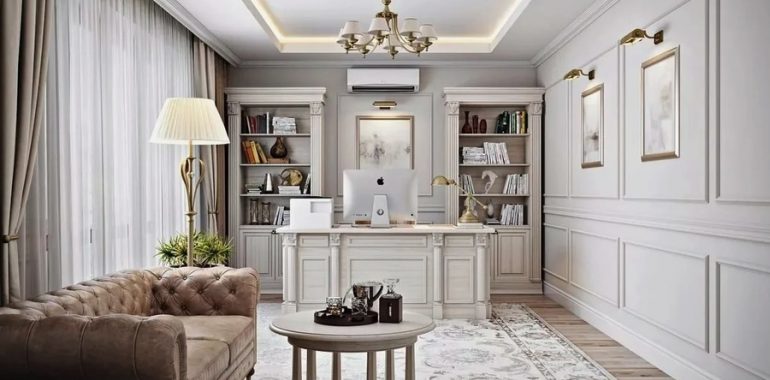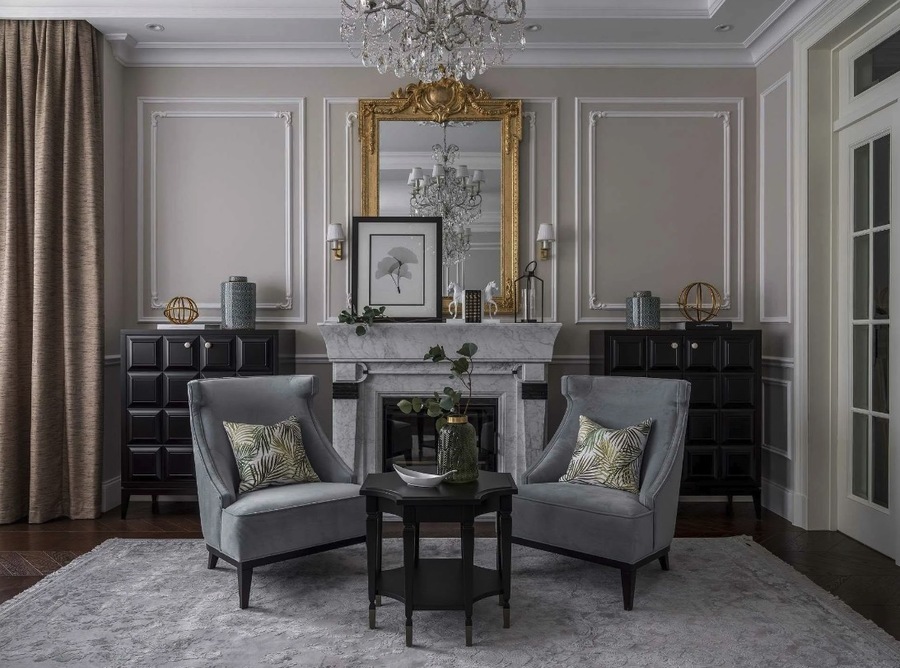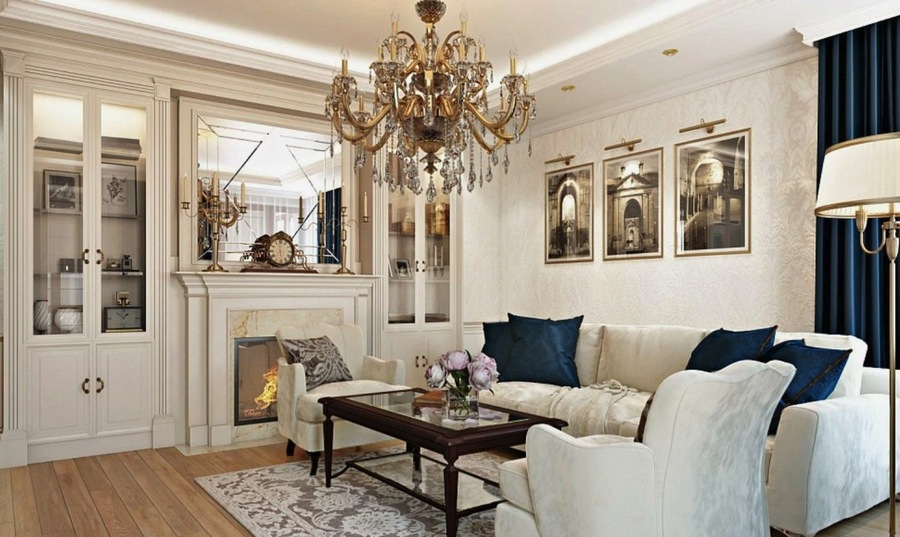Neoclassicism in Interior Design: A Comprehensive Guide

Neoclassicism, rooted in the revival of classical antiquity, epitomizes elegance and sophistication in interior design. Originating in the mid-18th century, this style draws inspiration from the art and architecture of ancient Greece and Rome, emphasizing simplicity, symmetry, and grandeur. In contemporary settings, neoclassicism seamlessly blends classical elements with modern functionality, making it a popular choice for apartment and home renovations. Bringing these elements together with the expertise of Vigilant Design & Renovation ensures that the design is both beautiful and functional.
Page Content
Neoclassical Style in Apartment and Home Renovations
Neoclassicism in the renovation of apartments and homes is characterized by a balanced mix of classical and modern elements. This style exudes an air of timeless elegance and grandeur while incorporating contemporary conveniences. Key features include:
Symmetry and Proportion: Neoclassical design is known for its emphasis on symmetry and proportion, creating harmonious and balanced spaces. Rooms are often arranged around a central focal point, such as a fireplace or a grand piece of furniture.
Classical Elements: Architectural features like columns, pilasters, cornices, and moldings are integral to neoclassical interiors. These elements, inspired by ancient Greek and Roman architecture, add a sense of grandeur and historical depth to the space.
Luxurious Materials: High-quality materials such as marble, granite, and rich woods are commonly used. These materials not only add a touch of luxury but also ensure durability and longevity.
Elegant Furniture: Furniture in neoclassical interiors is typically elegant and refined, with clean lines and classical forms. Pieces often feature intricate carvings, gilded details, and luxurious upholstery.
Detailed Interior Design in Neoclassical Style
Designing an interior in the neoclassical style involves careful attention to detail and a thoughtful blend of classical and contemporary elements. Key aspects include:
– Walls and Ceilings: Walls are often adorned with ornate moldings, wainscoting, and classical motifs. Ceilings may feature decorative plasterwork, coffered designs, and grand chandeliers.
– Floors: Flooring materials like marble, hardwood, and parquet are common in neoclassical interiors. Patterns such as herringbone or chevron add visual interest and elegance.
– Lighting: Chandeliers, sconces, and candelabras made of crystal, bronze, or brass provide a sense of opulence. These lighting fixtures are often designed with classical motifs and intricate details.
– Textiles: Luxurious fabrics such as silk, velvet, and brocade are used for upholstery, draperies, and cushions. These textiles often feature classical patterns like damask and toile.
– Accessories: Decorative accessories, including sculptures, vases, and paintings, often depict classical themes and motifs. Mirrors with ornate frames and classical busts are also common.
Neoclassicism in Interior Forks
In interior forks, neoclassicism is expressed through the careful selection of materials, furniture, and decorative elements that reflect classical ideals. Key features include:
– Classical Motifs: Elements such as laurel wreaths, acanthus leaves, and Greek key patterns are frequently used in decorative details and accessories.
– Architectural Details: Columns, pilasters, and arches are prominent features in neoclassical forks, adding a sense of grandeur and historical authenticity.
– Refined Color Palette: The color scheme typically includes muted tones like cream, beige, and soft pastels, complemented by richer hues such as burgundy, navy, and emerald.

Neoclassicism in Apartment Interiors
Neoclassical design in apartment interiors focuses on creating a sophisticated and elegant living space that maximizes available space while maintaining a sense of grandeur. Key elements include:
– Space Optimization: Efficient use of space is crucial in apartments. Built-in storage solutions, multifunctional furniture, and thoughtful layouts help create a spacious and organized environment.
– Elegant Furnishings: Furniture pieces are carefully selected to balance style and functionality. Sofas, armchairs, and dining sets feature classical forms and luxurious upholstery.
– Decorative Accents: Mirrors, artwork, and decorative accessories are strategically placed to enhance the sense of space and add visual interest.
Furniture in Neoclassical Interiors
Furniture in neoclassical interiors is characterized by elegance, refinement, and classical inspiration. Key characteristics include:
– Classical Forms: Furniture pieces often feature classical forms such as cabriole legs, fluted columns, and intricate carvings. Sofas and chairs may have rolled arms and tufted backs.
– Luxurious Materials: High-quality materials such as mahogany, walnut, and gilded wood are commonly used. Upholstery materials include silk, velvet, and leather.
– Ornate Details: Decorative details such as gold leaf accents, inlays, and marquetry add a touch of opulence to furniture pieces.
Materials for Finishing Surfaces in Neoclassicism
The choice of materials plays a crucial role in achieving the luxurious and elegant aesthetic of neoclassical interiors. Examples include:
– Marble: Used for flooring, countertops, and decorative accents, marble adds a sense of luxury and timeless beauty. Popular varieties include Carrara and Calacatta.
– Granite: Durable and elegant, granite is often used for countertops and flooring. Its natural patterns add visual interest and sophistication.
– Wood: Rich woods like mahogany, oak, and walnut are used for flooring, paneling, and furniture. These materials add warmth and depth to the interior.
– Plaster: Decorative plasterwork is used for moldings, cornices, and ceiling medallions. This material allows for intricate detailing and classical motifs.
– Gilding: Gold leaf and gilded finishes are applied to furniture, frames, and decorative elements to enhance the sense of opulence.

Color Scheme in Neoclassical Interiors
The color scheme in neoclassical interiors is refined and elegant, often featuring a neutral base with rich accents. Key colors include:
– Neutrals: Cream, beige, and white create a timeless and sophisticated backdrop. These colors enhance the sense of space and light.
– Rich Accents: Deep hues like burgundy, navy, emerald, and gold add depth and luxury. These colors are often used in upholstery, draperies, and accessories.
– Soft Pastels: Soft shades of blue, green, and pink add a touch of elegance and subtle color. These pastels are often used in wall treatments and textiles.
End Note
No matter what style you choose, it is extremely important to bring it to life with the help of real professionals. Vigilant Design & Renovation offers international quality, ensuring your interior is both beautiful and functional. With their expertise, you can create stunning designs that reflect your personal style and enhance your living space.